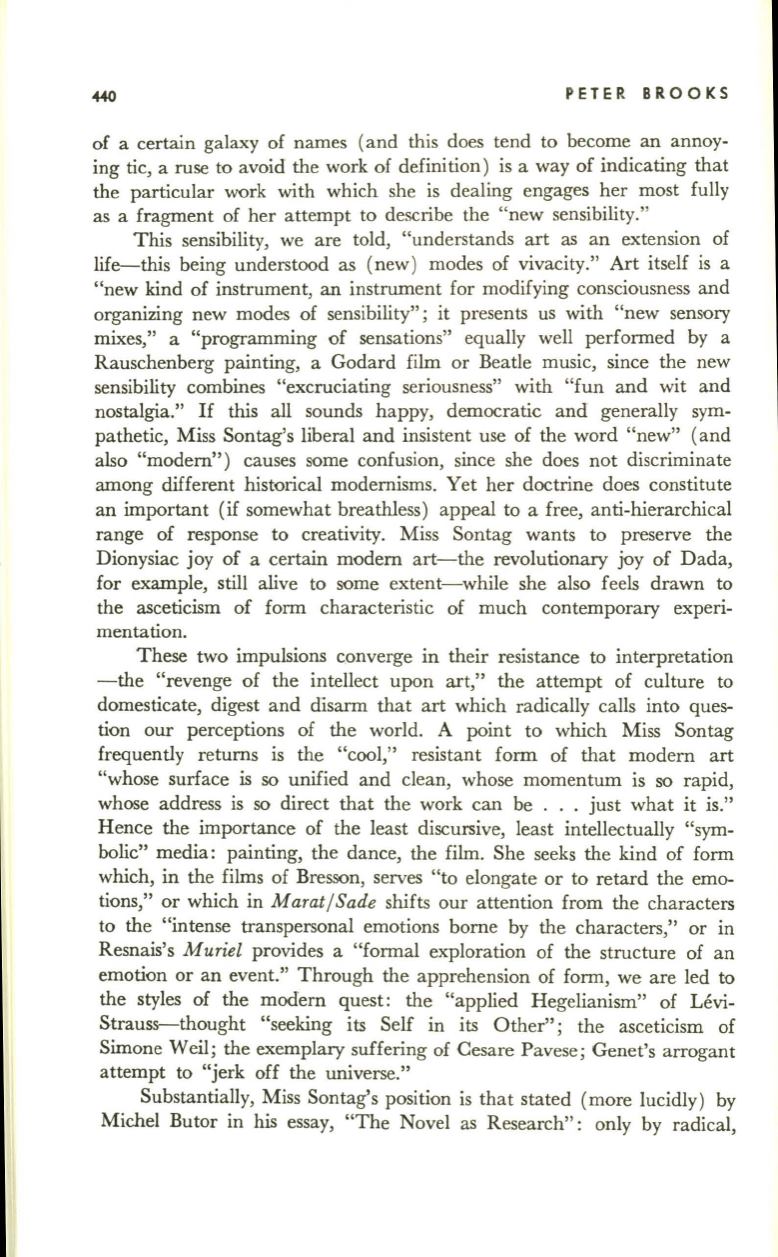
PETER BROOKS
of a certain galaxy of names (and this does tend to become an annoy–
ing tic, a ruse to avoid the work of definition) is a way of indicating that
the particular work with which she is dealing engages her most fully
as a fragment of her attempt to describe the "new sensibility."
This sensibility, we are told, "understands art as an extension of
life-this being understood as (new) modes of vivacity." Art itself is a
"new kind of instrument, an instrument for modifying consciousness and
organizing new modes of sensibility"; it presents us with "new sensory
mixes," a "programming of sensations" equally well performed by a
Rauschenberg painting, a Godard film or Beatie music, since the new
sensibility combines "excruciating seriousness" with "fun and wit and
nostalgia."
If
this all sounds happy, democratic and generally sym–
pathetic, Miss Sontag's liberal and insistent use of the word "new" (and
also "modem") causes some confusion, since she does not discriminate
among different historical modernisms. Yet her doctrine does constitute
an important (if somewhat breathless) appeal to a free, anti-hierarchical
range of response to creativity. Miss Sontag wants to preserve the
Dionysiac joy of a certain modem art-the revolutionary joy of Dada,
for example, still alive to some extent-while she also feels drawn to
the asceticism of form characteristic of much contemporary experi–
mentation.
These two impulsions converge in their resistance to interpretation
-the "revenge of the intellect upon art," the attempt of culture to
domesticate, digest and disarm that art which radically calls into ques–
tion our perceptions of the world. A point to which Miss Sontag
frequently returns is the "cool," resistant form of that modem art
"whose surface is so unified and clean, whose momentum is so rapid,
whose address is so direct that the work can be . . . just what it is."
Hence the importance of the least discursive, least intellectually "sym–
bolic" media: painting, the dance, the film. She seeks the kind of form
which, in the films of Bresson, serves "to elongate or to retard the emo–
tions," or which in
Marat/Sade
shifts our attention from the characters
to the "intense transpersonal emotions borne by the characters," or in
Resnais's
Muriel
provides a "formal exploration of the structure of an
emotion or an event." Through the apprehension of form, we are led to
the styles of the modem quest: the "applied Hegelianism" of Levi–
Strauss-thought "seeking its Self in its Other"; the asceticism of
Simone Weil; the exemplary suffering of Cesare Pavese; Genet's arrogant
attempt to "jerk off the universe."
Substantially, Miss Sontag's position is that stated (more lucidly) by
Michel Butor in his essay, "The Novel as Research": only by radical,


